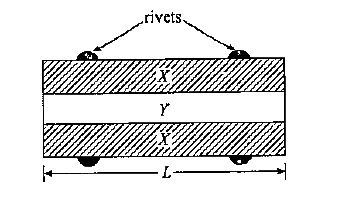The systeam shown is figure consists of 3 springs and two rods. If the temperature of the rod is increased by ΔT, then the total energy stored in three springs is β×99484kL2α2(ΔT)2. Datermine the value of β. The soring are initially relaxed and there is no frication anywhere. For rod the coefficient of linear expansion is α
_E01_089_Q01.png)
The correct Answer is:C
Let x1,x2 and x3 be the compression is three springs respectively, when the temperature of the rod is increased by ΔT.
Elongation in rod of length L is l1=LαΔT
Elongation in rod of of length L2 is, l2=LαΔT2
Total elongation, l1+l2=3LαΔT2
x1+x2+x3=3LαΔT2 From equilibrium of rods
kx1=2kx2=3kx3
Solving above equation we get,
x1=911LαΔT
x3=311LαΔT
Total energy stored in 3 springs is,
U=kx212+2kx222+3kx232
=297484×Kα2L2(ΔT)2
So, β=3
Topper's Solved these Questions
- THERMAL PROPERTIES OF MATTERBook:NARAYNAChapter:THERMAL PROPERTIES OF MATTERExercise:LEVEL - I (H.W.)
Explore 22 Videos
- THERMAL PROPERTIES OF MATTERBook:NARAYNAChapter:THERMAL PROPERTIES OF MATTERExercise:LEVEL - II (H.W.)
Explore 19 Videos
- THERMAL PROPERTIES OF MATTERBook:NARAYNAChapter:THERMAL PROPERTIES OF MATTERExercise:LEVEL - V
Explore 12 Videos
- SYSTEM OF PARTICLES AND ROTATIONAL MOTION Book:NARAYNAChapter:SYSTEM OF PARTICLES AND ROTATIONAL MOTION Exercise:EXERCISE - IV
Explore 39 Videos
- THERMODYNAMICSBook:NARAYNAChapter:THERMODYNAMICSExercise:Exercise
Explore 187 Videos
Similar Questions
The system shown in figure consists of three springs and two rods as shown. If the temperature of the rods is increased by δ(t) calculate the energy stored in each of the springs. The springs are initially relaxed. There is no friction.

View SolutionBy how much amount should the temperature of a steel rod be increased so that its length increases by 0.5%? The coefficient of linear expansion of steel is 1.2×10−5C−1
View Solution
Knowledge Check
How much should the temperature of a brass rod be increased so as to increase its length 3% (α for brass is 2×10−5/∘C−1)?
A1500∘CB150∘CC2000∘CD2500∘CThe moment of ineratia of a uniform thin rod about its perpendicular bisector is I. If the temperature of the rod is increased by Δt , the moment of inertia about perpendicular bisector increases by (coefficient of linear expansion of material of the rod is α).
AZeroBIαΔtC2IαΔtDIαΔtWhen solid is heated , its length changes according to the relation l=l0(1+αΔT) , where l is the final length , l0 is the initial length , ΔT is the change in temperature , and α is the coefficient of linear is called super - facial expansion. the area changes according to the relation A=A0(1+βΔT), where A is the tinal area , A0 is the initial area, and β is the coefficient of areal expansion.
The coefficient of linear expansion of brass and steel are α1andα2 If we take a brass rod of length I1 and a steel rod of length I2 at 0∘C , their difference in length remains the same at any temperature ifAα1l2=α2l2Bα1l22=α2l21Cα21l2=α22l1Dα1l1=α2l2
Two rods of material X sandwich another rod of material Y as shown in figure. At temperature t, the three rods are in a state of zero strailn and of length L and riveted to each other in this state. If the temperature of the system increases to T+ΔT, find the final length of the system of the three rods. Given that the coefficients of linear expansions of the roods and their Young's modulus for material X and Y are alpnax,αy,Yx and Yy respectively. Consider αy>αx.

View SolutionTwo rods of different materials but having same length L and cross-sectioinal areas A are arranged end-to-end between fixed supports. The temperature is T and there is no initial stress. The rods are heated so that their temperature increases by ΔT. Find : (a) the displacement of the interface (b) the stress at the interface. The coefficinets of linear expansioin of the materials are α1 and α2 and their Young's modulii are E1 and E2 respectively.
View SolutionA brass rod is 69.5 cm long and an aluminum rod is 49.0 cm long when both rods are at an initial temperature of 0∘C. The rods are placed in line with a gap of 1.5mm between them. The distance between the far ends of the rods remains same throughout. the temperapure is raised until the two rods are barely in contact. The coefficients of linear expansion of brass and aluminum are 2.0×10−5K−1 and 2.4×10−5K−1 respectively. In figure, the temperature at which contact of the rods barely occurs, in .∘C is closest to:
z
View SolutionA composite rod is made by joining a copper rod, end to end, with a second rod of different material but of the same area of cross section. At 25∘C, the composite rod is 1m long and the copper rod is 30cm long. At 125∘C the length of the composte rod increases by 1.91mm. When the composite rod is prevented from expanding by bolding it between two rigid walls, it is found that the constituent reds have remained unchanged in length in splite of rise of temperature. Find yong's modulus and the coefficient of linear expansion of the second red (Y of copper =1.3×1010N/m2 and a of copper =17×10−6/K).
View SolutionTwo rods of different materials and identical cross sectional area, are joined face to face at one end their free ends are fixed to the rigid walls. If the temperature of the surroundings is increased by 30∘C, the magnitude of the displacement of the joint of the rod is (length of rods l1=l2=1unit, ratio of their young's moduli, Y1/Y2=2, coefficients of linear expansion are α1 and α2)
View Solution
